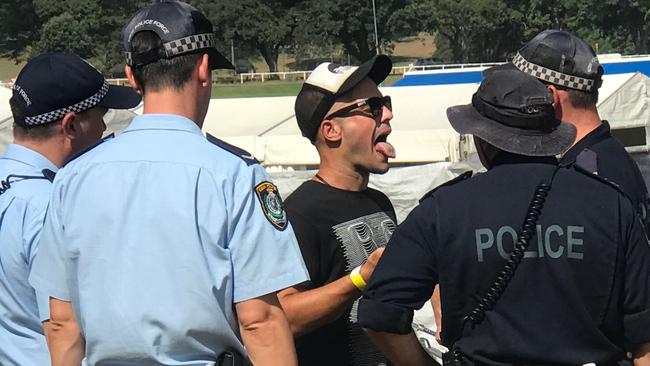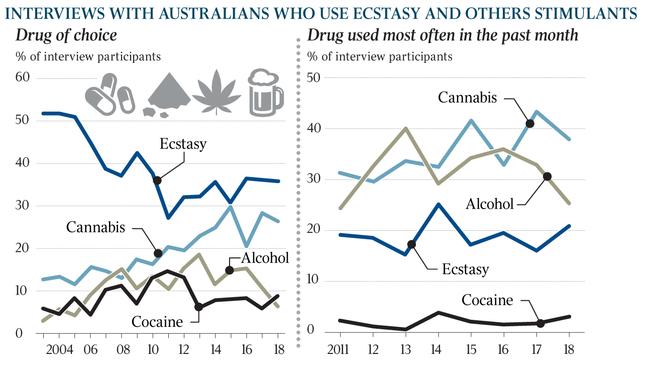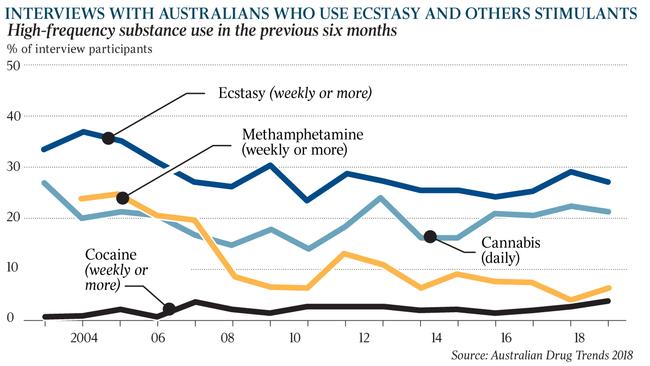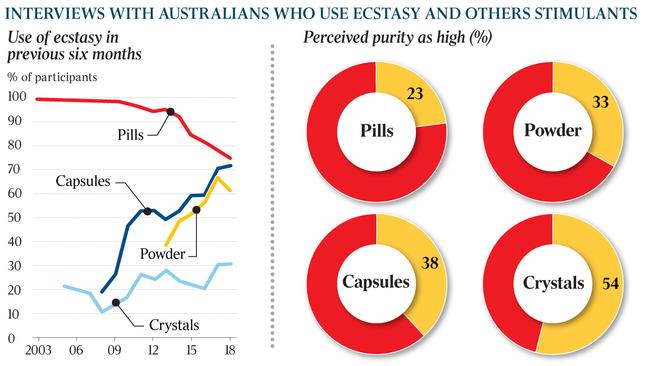Dancing with the devil
Drugs such as ecstasy have become commonplace in Australia’s dance raves, and authorities are still seeking to find a solution.

The young man smirks as he leans against a fence near the entrance of the Electric Gardens music festival in Sydney’s Centennial Park.
“I’m watching my drugs walk through the gates as we speak,” he said on Saturday, as thousands of revellers’ tickets were scanned and their bags checked by police in a crackdown on drugs.
The 24-year-old, who declined to give his name to The Australian, had asked his friend to carry in 20 MDMA capsules — or 2g of ecstasy — and said he planned to bring in five “tabs” of acid himself.
At the entrance, security guards confiscated water bottles and chewing gum — twin essentials for ecstasy users who need to rehydrate and tend to clench their jaws as they hit their peak — as well as blister packets of “Panadol”. But they let in revellers who appeared to have the jitters and shakes from substances they had taken earlier.
The “zero drug policy” of the festival organisers was wilting in the summer heat of Australia Day.
Within two hours of the first electronic beats erupting, a woman was taken out on a stretcher after she appeared to be overdosing in the police drug-checking area. Inside, the crowd was entranced. Dilated black pupils and wide serotonin-induced smiles marked the faces of young people engaged in random hugs and buzzing chatter.

MDMA was the drug of choice as music fans could be heard asking each other if they “had any caps”. The party drug stimulates feelings of affection and closeness, even among strangers, by making the brain pump serotonin and dopamine.
In total, eight people were sent to hospital from Electric Gardens and 10 people were charged with drug supply.
Australians are among the world’s biggest consumers of ecstasy — also known as eckies, E, XTC, pills, pingers, bikkies, flippers and molly.
Every week across the country, thousands take ecstasy at nightclubs, parties and music festivals.
But they are relying on a black market controlled by criminal gangs who manufacture and distribute the drug, with no regulation or quality controls.
The main ingredient in ecstasy is meant to be MDMA, a psychoactive drug with hallucinogenic effects. Yet many pills sold as ecstasy have only a small amount of MDMA or none at all.
Studies have shown ecstasy tablets often contain lethal substances designed to mimic the effects of MDMA, including methamphetamine, synthetic cathinones (commonly known as “bath salts”) and PMA, an amphetamine-type drug that is toxic.
This means users have no idea what they are ingesting, making it impossible to predict any potentially adverse reactions or other side effects.
Ecstasy has been the favoured drug since 2003 for people who use stimulants, the National Drug and Alcohol Centre report Australian Drug Trends 2018 found.
In interviews with drug users for the report last year, 36 per cent said they preferred ecstasy over cannabis (26 per cent), alcohol (8 per cent), cocaine (7 per cent) and other substances.
Of the 799 drug users interviewed last year, 27 per cent reported weekly or more frequent use of ecstasy.

The ecstasy market has diversified in the recent years, according to the report.
The drug can be bought in the form of pills, powder, capsules and crystal. The use of pills has declined in the past few years as demand shifts to capsules and crystal.
“These changes may be partially explained by differences in perceived purity, with ecstasy capsules and crystal reported to be of higher purity than pills and powder,” the report found.
Australia’s only pill testing trial, at last year’s Groovin the Moo festival in Canberra, found toxic chemicals, along with toothpaste and paint, in many of the drugs.
At the other extreme, some pills contain dangerously high levels of MDMA. Researchers in the field say it’s not uncommon to find more than 300mg of MDMA in a single tablet — more than three times the standard dose.
In the past five months, five people — Alex Ross-King, 19; Josh Tam, 22; Callum Brosnan, 19; Joseph Pham, 23; and Diana Nguyen, 21 — have died in NSW after taking illicit drugs at music festivals. In the wake of these deaths, health professionals and other advocates have increased their calls for pill testing.
After two deaths at the Defqon. 1 festival in September, NSW Premier Gladys Berejiklian strongly ruled out pill testing.
“Unfortunately, we know that pill testing won’t work because it will give people the green light to take substances which in the end could still kill them,” she said.
Berejiklian later established an expert panel to devise strategies aimed at making festivals safer, but this will not include an analysis of the merits of pill testing.
Supporters concede it’s no silver bullet but they claim it will reduce harm and save lives.
They say substances identified by the tests as dangerous would leave the market, putting pressure on manufacturers to refrain from using contaminants as “fillers”. As well, negative results would stop many people from continuing to use drugs.
According to Harm Reduction Australia, about 40 per cent of people who had their pills tested at Groovin the Moo said they would change their drug-taking behaviour as a result of the information provided by the service. About 20 per cent said they would throw away the drugs or were uncertain what they would do.

An evaluation of a pill testing trial in Britain last year found one in five substances contained unexpected substances, and that two-thirds of these customers chose to hand over their drugs to be destroyed. It also showed a 95 per cent reduction in hospital admissions from festivals at which the testing was being carried out.
Opponents of pill testing say it sends the wrong message by effectively condoning illicit drug use. Worse, it could leave drug users with a “false sense of security” that the drugs they buy are safe when they may not be.
At the Groovin the Moo trial, people handed a sample of their drugs to a chemist who photographed and weighed it.
The chemist then labelled the sample as white (the substance is what the person anticipated), yellow (the substance is different to what the person anticipated) or red (the substance is associated with increased harm or death, or cannot be identified).
That information was then given to a doctor who outlined the potential dangers of ingesting the substance. A drug counsellor was also on hand to discuss the risks. Before leaving the tent, people were able to dispose of their drugs in an “amnesty bin”.
At the Electric Gardens festival on Saturday, a 21-year-old from Sydney’s northern beaches told The Australian he was relying on drug dealers’ own testing kits for peace of mind.
“I thought my pills were a dud from the first guy I was going to buy off, but when the second dealer showed me a small test tube of a sample of his drugs that turned purple, I knew they were good and I trusted him,” he said.
Later in the day, at Hardcore Til I Die — a rival electronic music festival 20km away in the Sydney Showground at Sydney Olympic Park — dance fans massaged each other’s heads and legs as their muscles tingled and relaxed from the drugs that had just kicked in.
One girl brought a Vicks nasal inhaler up to her nose, closing her eyes as she breathed in the menthol, which is believed to enhance the high.
Others crouched on the dance floor and stared as though they were hypnotised by revellers wearing LED-lit gloves.
They appeared to be putting on a “light show” for drug users whose eyes became sensitive to light under the influence of MDMA.
Safety messages saying “don’t risk your life with drugs” were flashing on an LCD screen in the middle of the arena. But empty zip-lock bags, used lollipops and bulbs of nitrous oxide or “laughing gas” were strewn across the dance floor.
Festival-goers boasted of cunning methods of smuggling the drugs through the increased police presence. Cleaners at the festival found condoms that were used to conceal drugs inside the bodies of festival goers. One said she saw coffee grounds in condoms, which she believed were used to mask the smell of their drugs.
Laxatives were found in many cubicles after revellers used them to remove drugs they had inserted into their backsides.
A woman looked distressed as a police dog’s nose sniffed up her fluoro green skirt before alerting officers by sitting at her feet. She was taken away to be searched.
One young man, who was bleeding from his mouth as he clenched and unclenched his jaw at Electric Gardens, opted for a simpler option: “I just hide it in my cigarette box and put it in my pocket because the dogs can’t smell it.”
Most party goers said they were aware of the rumbling debate around pill testing.
“Why don’t they ask us what we want?” said one attendee.
Another admitted he would buy tickets to a festival just to get his drugs tested so he could use them on another weekend.
Jodie, 30, who chose not to share her last name, is a registered nurse and said she supported pill testing because “it would reduce the burden on the healthcare system”. “It’s a preventable death,” she said. “It’s about education and if people know what they’re taking, they won’t take it.”
Secondary schoolteacher Sasha, who was at Electric Gardens, called for more “progressive views” in the discussion of drug use in the classroom.
“I know I often say too much in the classroom but I do so in an effort to ensure students are educated about the realities of drug taking and how to do it safely rather than scaremongering the community,” she said.
Fourteen people were rushed to hospital on Saturday night with three in a critical or serious condition. A spokesperson from NSW Health said drugs were likely to have been a factor in 10 of those cases but confirmed yesterday they had all been stabilised.
Heat exhaustion was the cause of distress among some revellers as a girl, visibly unwell, was cooled by friends who rubbed iced water over her skin. Police marched past without checking on her.
By 6pm the free water bottles previously handed out by volunteers had been rationed for emergencies only. They were preparing to be bombarded with unwell revellers after sunset.
A total of 10 people were charged with drug-supply offences and a further 47 were issued drug criminal infringement notices, across both Sydney festivals.
A 17-year-old boy from Castle Hill who allegedly was carrying 579 capsules and $2075 cash will appear at a children’s court on February 20.
At HTID, police said 183 people were searched with seven people charged with supplying prohibited drugs.
But an 18-year-old called Jack, from the Sutherland Shire in southern Sydney, says the drug culture can never be wiped out.
“This generation is going to do it,” he said.
There’s no stopping it. If you look around I reckon about 85 per cent of people are on it here.”


